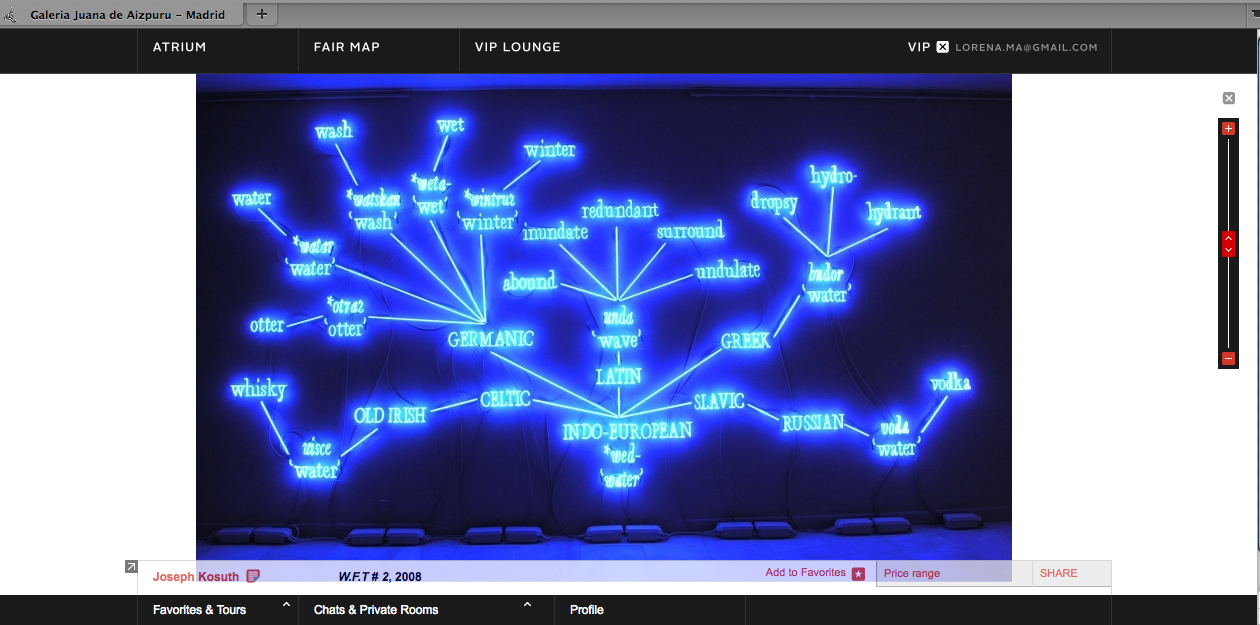On the Saturday 22nd of January at 8pm all eyes were set on a very particular website: the very first online art fair. Baptised VIP (which stands for Viewing In Private) it offers –or so it claims– all the perks of visiting high profile brick-and-mortars fairs such as Frieze or Art Basel – namely, accessing first class works by first class artists represented by first class galleries– without any of the pressure or inquisitive looks of fellow collectors or intimidating super sleek dealers. Are we witnessing the birth of the new model of art fair, soon to efface its 'earthy' competitors?

With a less than impressive beginning (the site was down or with severe technical problems during most of the two first days) the fair managed to overcome such faux pas and by last Monday it was up and running more or less properly. The integrated chat systems had to be disabled, though, due to the stress it was producing on the unprepared server of the site.
The chat was, quite worryingly, the key interactive feature of this experimental venture, the only direct way to access the people behind the virtual interface: the dealers. Telephone and skype calls and emails were subsequently encouraged to prospective buyers to contact galleries and proceed with questions and purchases. With regular Facebook and Twitter updates, half the time in apologetical tone, the VIP team has braved the storm with the best attitude possible and, truth be told, the fair has created quite a stir in both the online and art communities. After all, if they site crashed during the launch it was due to the huge volume of visits, and everyone in the art world seems to be talking about it, whether to praise or criticise it.
But tech failures and controversies aside,what are the strongest and weakest points of VIP Art Fair?
PROSThe selection of 135 galleries is definitely first class. With heavy weight galleries like Gagosian, Hauser & Wirth, White Cube, Barbara Gladstone or Emmanuel Perrotin on the Premier Large section (to name but few) and exciting younger galleries like Pilar Corrias, Johann König, Herald St. o Labor in the Emerging section, the public is sure to find a brilliant selection of works, covering every essential artist in the contemporary art market.
The virtual booths in the fair are priced from $5,000 to $20,000, depending on the amount of works in display (from 8 works up to 20), the cost of participating is substantially smaller that a regular, brick and mortar fair (roughly a fifth of the price). To that one has to add that for this venture the galleries do not incur on shipping costs, and shipping the works from one country to another or to one one continent to another is usually where the galleries spend more money.

Showing the works just virtually, via pictures and/or videos, allows galleries to show huge and complex installations and pieces that can’t usually be transported and installed at a real fair due to logistics.
The video works are streamed, so the viewer can see them whenever is more convenient for him/her without any rush. And most galleries have added background information about the works and artists so, with a total of 2250 works on display the fair also becomes an exciting database for research for both collectors and art lovers alike.
You can buy art in your pyjamas and devote all the time you would have to spend deciding what to wear and air kissing to find great works and learning more about them.
CONSNo virtual experience can compare with actually experiencing the art in the flesh. It applies to every medium, but specially to painting, sculpture and immersive installations. How can a viewer grasp all the nuances on a laptop screen? Having said that, serious art collectors and buyers are nowadays very used to buy works they have only seen on the internet or by images sent by galleries by phone, and online rooms for auctions are by now a permanent fixture within the art market.
At the end of the day, the adrenalin of a real art fair, all the gazing around, gossiping and air kissing is what makes seeing and buying art exciting and fun. And a good dealer will always make a better sale in person, also showing directly other available works or artists. Or maybe not? We are curious to see the results and reports after the fair finishes.
The VIP Art Fair is live online until Sunday the 30th of January.
http://vimeo.com/16627417